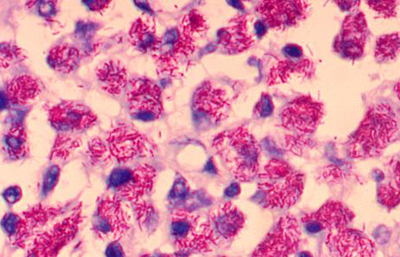Mycobacterium avium complex
CASE 1
• A 33 year old woman has weight loss over 4 months and intermittent fever, abdominal pain, and loose stools for 2 months. Her fevers recur each afternoon at about 4 pm and persist through the night. The abdominal pain is diffuse, but there is tenderness of the liver and enlargement of the spleen. Her stools are soft or loose, but they are non-bloody and non-mucoid.
• She was diagnosed with HIV 4 years earlier when she presented with pulmonary tuberculosis. She was treated with a full course anti-tuberculous therapy. She subsequently received antiretroviral therapy for 18 months; however, she became increasing intolerant of these drugs and has not been taking them for the past 2 years.
• On suspicion of disseminated M. avium complex infection, a sample of the patient’s blood was taken, treated with a lysis solution to rupture all of the erythrocytes, and centrifuged. The pellet was then cultured on special media for atypical mycobacteria. After 20 days, mycobacterial colonies of appeared and were later identified M. avium complex.
• The patient was treated with azithromycin and ethambutol. The fevers and abdominal pain improved but never resolved completely. 3 months later, the patient died from clinical features associated with an enlarging mass in the brain. A post-mortem examination comfirmed that the brain mass was a central nervous system lymphoma (unrelated to the mycobacterial infection but associated with terminal HIV infection). Biopsies and acid-fast staining of samples of the liver, spleen and a lymph node had the following appearance:

Questions:
1. What is M. avium complex (MAC), and what diseases does it cause?
2. How did the MAC most likely enter this patient’s body? How does this difference from infection with M. tuberculosis?
3. Looking at the tissue stain above, what about this photomicrograph argues against M. tuberculosis as the cause of the infection? How can these two pathogens (M. tuberculosis and MAC) be distinguished from one another when grown in culture?
4. This patient was cured of tuberculosis with treatment early in the course of her HIV infection but could not be cured of MAC infection later in the course. Why?
5. This degree of disseminated MAC does not occur in immunocompetent patients. What was the critical risk factor for developing MAC infection in this patient??
6. MAC infection is relatively rare in Ghana (~2% of all terminal AIDS patients) compared to industrialized countries (30 – 50% of all terminal AIDS patients in the U.S. who are not on antibiotic prophylaxis). Can you speculate why this might be so??
7. Will standard treatment for tuberculosis also treat MAC infection, if it is simultaneously present?
CASE 2
• A 12 year old girl has a slowly enlarging lymph node in the left anterior cervical chain over the past 6 weeks. She has no other enlarged lymph nodes. She has experienced no fever, chills, night sweats, or weight loss. She has no other complaints.
• The patient was born in Kumasi but has lived with her parents in the Southern United States for the past 4 years. The parents became concerned about the enlarging lymph node after the family returned to Ghana.
• The attending physician found no physical or laboratory abnormalities in this child. She treated the patient with sequential courses of cephalexin and amoxicillin-clavulantate with no improvement in the node enlargement. She therefore recommended referral to a surgeon for an excisional biopsy of the node.
• The node was removed in its entirely. Histological sections revealed an intense granulomatous reaction with a few acid-fast bacteria. A mycobacterial culture grew MAC after 4 weeks.
Questions:
1. How did the patient acquire the organism? How do you think this organism got access to a cervical lymph node but was not apparently localized anywhere else in her body?
2. Should this patient receive antimycobacterial therapy at this point?
3. If untreated, is she likely to develop the kind of dissemination witnessed in Case #1 above?